- Home
- John Barth
Final Fridays Page 2
Final Fridays Read online
Page 2
Perhaps he has; but the aforecited essay by Mr. Mark Amerika goes far to fill in any gaps in Mr. Sheter’s checklist of the contemporary Action. I quote again from Mr. Amerika: all kinds of viral shit festering there, not the least of which would include dissident comix, wigged out zines, electronic journals, quick-time hypermedia CD-ROMs, a voluminous melange of hardcore industrial grunge post-everything music, the Internet, surfpunk technical journals, interactive cable TV, . . . hypertext novels, . . . single-user films, gen-derfuck performance art spectacles . . . teenage mutant ninja gangsters, C-Span . . . feminist deconstruction . . . the list goes on.
And on and on and on: avant-pop, splatterpunk, cybersex—you name it, if you can, or make it up if you can’t. Indeed, it’s tempting to imagine that the pugnacious contributors to the ABR invent these wonderful catalogues as they go along; but I am assured by my more with-it informants—if scarcely reassured—that the items, however ephemeral, are for real.
If among the intentions of such in-your-face lists is to make us dinosaurs from “the late age of print” feel our dinosaurity, then they quite succeed. I confess to being out of the loop of contemporary American letters in their most aggressively avant-pop aspect. I cannot sing along with the “voluminous melange of hardcore industrial grunge post-everythings”; I cannot line-dance with the cybersexual splatterpunk avant-poppers. And while I do not revel in my end-of-the-century troglodytehood, I’m inclined to shrug my shoulders at it. I scan the American Book Review with considerable interest and amusement, likewise some of those “wigged-out zines” when my former students publish in them and kindly send me copies; I maintain a benevolent curiosity about hypertext (of which more presently) out of my long-standing interest in the nonlinear aspects of life and of literature. But the American perodicals that I actually subscribe to and thoroughly read are the New York Review of Books, Harper’s, the Sciences (the journal2 of the New York Academy of Sciences, which my wife and I enjoy as much for its art as for its articles), and Scientific American—the latter two partly as a source of fictive metaphors. Also Sail magazine, but never mind that, and Modern Maturity, the journal of the American Association of Retired Persons, which subscribes to me more than I to it; I look through it, but I don’t inhale. The current American fiction that I most relished while preparing these remarks happens to have been John Updike’s latest collection of short stories, The Afterlife, and William H. Gass’s monumental novel The Tunnel—two comparably masterful though radically different works of literary art from “the late age of print.” They make me pleased to have lived before the transition from “the book as we know it” to the “writing [of] the mind in lightforms” is complete.
Let me say at once, however, that I do not doubt the reality of that transition. Granted that a few writers still compose on the typewriter, even on manual typewriters: Saul Bellow says that he uses two, one for fiction and the other for nonfiction; my Johns Hopkins colleague Stephen Dixon worries that his prolific fiction-writing career will crash when he can no longer find anybody to service his brace of Hermes manual portables, or to supply ribbons for them. A very few of us, believe it or not, still prefer to draw out our first-draft sentences the even older-fashioned way, with fountain pen on paper.3 Despite these exceptions, however, most of my comrades in arms and all of my recent students compose their fiction on word processors, and of the few of us who don’t, most (myself included) depend absolutely on our computers for editing and revision, whether we do that on hard-copy print-outs or directly onscreen.4 Our publishers now routinely expect the finished product on disk or e-mail attachment as well as on paper, and the hottest, thorniest issue these days in the Authors Guild Bulletin (another “zine” that subscribes to me) is the protection of its members’ electronic rights in our book and magazine contracts, as more and more of our originally printed publication goes online one way or another down the road, and our control of copyright tends to evaporate in cyberspace. Although I might disagree with Mr. Michael Joyce about the implications of his proposition, I quite concur with the proposition itself: that we are indeed in “the late age of print,” not only as a means of producing and publishing literature, but, importantly, as a means of reading it. One New York playwright recently described all of us authors-for-print as “roadkill on the information superhighway.” He may be right.
To afford some perspective on this “transitional time,” I want to back up a bit now: first just a few years back, then a few decades back, if not farther yet, always keeping a navigator’s eye on where we are and where we seem to be going, literature-wise, as we briefly retrace where we’ve been (this is the Sail magazine approach to navigating the State of the Art).
A MERE 15 years ago, in 1981, we received at the Johns Hopkins Writing Seminars our very first word-processored manuscript in an application to our graduate program in fiction-writing. Although the piece itself was unremarkable, I was impressed by its virtually published look; it was, in fact, an early specimen of “desktop publishing.” Remembering how instructively chastened I myself had been in the early 1950s to see my own apprentice efforts first set in official, impersonal print in a student magazine—which seemed to me to make strikingly manifest both their small strengths and their large shortcomings—I imagined that this newfangled mode of manuscript-production might afford our apprentice writers some measure of the critical detachment that print confers. The farther their words were removed from longhand, I reasoned, and even from homely old-fashioned typescript, the more objectively the apprentice authors would be able to assess them.
And so I showed the handsome specimen to our visiting fiction coach that year (Leonard Michaels) and expressed my pedagogical sentiments: wave of the future, et cetera. Michaels took one suspicious look at the justified right-hand margins, the crisp print, and handsome typefaces, and said, “This is terrible! They’re going to think the stuff is finished, and it only looks that way!”
He was right, of course. Indeed, I came to repeat this anecdote annually to each new crop of my graduate-student apprentices by way of cautioning them against fancy presentations of what is, after all, still work in process. No desktop publishing, please, I advise them: Just give us and your future editors tidy, well-copyedited pages, remarkable only for their author’s brilliance, and let’s leave publishing to the publishers.
That was in 1981. Thirteen years later, in 1994, we had our first ambassador from the vertiginous realm of Hypertext, a.k.a. “e-fiction”: interactive computer-fiction in which the “author” designs a matrix of “lexias” through which the “reader” navigates with clicks of the mouse or the keyboard, perhaps entering or exiting the narrative at any of many available doors and steering the plot along any of many optional way points.
The seminal work on the medium itself (Hypertext, authored by George Landow of Brown University, but published by our Johns Hopkins Press in 1992) declares hypertext to be the third great technological advance in the art of writing, after the development of the alphabet and the invention of movable type. Some curmudgeons have grumbled that the whole thing is more hype than text, but my comrade Robert Coover, also at Brown, has become so involved in the medium that his official academic title these days is Professor of Electronic Fiction. In 1993, Coover published two landmark front-page essays on the subject in the New York Times Book Review, one called, provocatively, “The End of Books?” (it’s important to hear that question mark at the end of his title), and the other called “Hypertext: Novels for the Computer.”
I INVITE ANY innocents still unfamiliar with hypertext to imagine a “text” (the word is already in quotes, the signal or symptom of virtuality), every word of which—at least many a key word of which—is a window or point of entry into a network of associated “texts” (or graphics, music, statistics, spoken language, whatever a computer can reproduce), these several networks themselves interconnected and infinitely modifiable—or virtually infinitely so—by “readers” who can enter the “story” at any point, trace any of a
zillion paths through its associated networks, perhaps add or subtract material and modify the linkages as they please, and then exit at any point, in the process having been virtual co-authors or co-editors as well as “readers” of their virtual text. That’s hypertext.
The quick brown fox jumps over the lazy dog. Imagine a “loaded” display of that innocent proposition on your computer screen, such that “clicking” on any item in it opens a window menu of associations available for exploring, from the relative nimbleness of temperate-zone quadrupeds, through the history of fox hunting and its representation in painting, music, and literature, to soundtracks of hounds in full cry (with or without expert commentary) and disquisitions on animal rights—and every one of those associated “lexias” similarly loaded, another ring of keys with which one may open yet further doors, and on and on and on—no two routes through the maze ever likely to be the same, and every venturer thereinto not only a Theseus but a Daedalus, remodeling the labyrinth at will en route through it. That’s hypertext, more or less, and as a potential medium of art it both intrigues and disquiets me. If the prophets of the American Book Review, not to mention the New York Times Book Review, are correct, as no doubt they are, we’ll be hearing more and more about it as our weary century expires (it has already made the cover of Time). Indeed, a recent number of the Authors Guild Bulletin (Winter 1995), along with its now-standard cautionary piece on “Fair Use in the Electronic Age,” included its first-ever mention of hypertextual narrative: “Electronic Fiction,” by Sarah Smith (subtitled “The State of the Art”). An articulate practitioner of and apologist for her medium, Smith quotes a fellow hypertextualist’s decription of their art as “designing golf courses with holes that can be played in any order by players with greater or lesser degrees of skill and commitment.” I like that metaphor—although I modestly submit that “ski slopes” would be an even better one, since, unlike golf courses, they have no prearranged sequence to be ignored or altered.
Back to my story. We welcomed our young graduate-student pioneer, Ho Lin—who had already worked with Coover and Landow in Brown University’s vigorous hypertext program—into our Hopkins Seminars, as did our university library into the organizing of its burgeoning CD-ROM operation: a genial and knowledgeable harbinger, I reckoned, of things inevitably to come. Fortunately for us, who had neither equipment nor expertise nor, for that matter, sufficient departmental enthusiasm to deal with this novel medium—it turned out that Mr. Lin’s Hopkins project was a straightforward, engaging, traditionally linear print-novel (“p-fiction,” I guess we have to call it now) about young Chinese-Americans dreaming of Hong Kong and heisting computer chips to get there. At my urging, however, he obligingly arranged “e-fiction” demonstrations for us at the university’s computing facility, and we did a certain amount of disk-and-software swapping.
Now, I’m a book-person myself, but I try to keep an open mind and a mindful eye on the parameters of the medium. I had already read Coover, Landow, and others on the subject of hypertext; if I were 25 instead of 65-plus, I daresay that I would be vigorously exploring its possibilities for my fictive purposes. I rather expected our roomful of talented Hopkins apprentices—who, after all, grew up with desktop computers—to take to hypertext fiction like grade-schoolers to Nintendo. Has it not been the job, after all, of each new artistic generation since the advent of Romanticism to render its senior mentors gently obsolete (what one sociologist has called “filiar-chy,” the rule of the young over their elders, and what others might call “parricide”)? To my surprise, however, I found that I was doing the prodding—“Better expose yourselves to the virus, if only to build up your antibodies,” et cetera—and that they, for the most part, were taking the skeptical Leonard Michaels role. Reading and writing literature in the normal way, most of them felt, is interactivity enough; when we’re being writers, we’ll plot the course for you; when we’re being readers, leave us alone and steer the boat yourself. My feelings exactly—more or less exactly, anyhow—but I confess that it was a touch dismaying to hear them voiced by young apprentices.
In any case, their sentiments are sound, I believe, if unadventurous. Note that their reservations were not to the tiresome business (as many of us find it) of reading for pleasure off a video display terminal rather than curled in a comfortable chair; we agreed that by this century’s turn, the hardware for hypertexts will likely be as portable and maybe even no harder on the eyes than that jim-dandy item of low-energy, high-density information technology, the printed book. Nor had they anything against hypertext as a high-tech mode of reference browsing. What they objected to, and in this I’m much more with them than not, was mucking around with the traditional job-descriptions of Author and Reader. “You don’t like the restaurant? Then dine elsewhere—but stay out of my kitchen while I’m cooking for you, please, and I’ll return the favor.” (You ought, however, to try the hypertextual broccoli before making up your mind.)
I mention these two instances, from fifteen and two years ago, as straws in the potentially much bigger wind of Electronic Virtual Reality, which I won’t attempt to consider more than briefly here. My point is that although a few of us still prefer to compose our sentences in longhand before turning them into pixels on a computer monitor en route to their returning into print on a page, and a few more prefer still to eschew computers altogether, the super-convenient word-processor has become, in only a dozen-plus years, the production mode of choice for most writers of most kinds of writing, whether or not it affects the quality of the product. Interactive computer fiction (especially as it comes to include whole repertories of graphic, cinematic, and auditory effects) is too fascinating not to become yet another competitor for audience attention, but one doubts that it will have nearly the market-share effect on “straight” fiction-reading that movies and television—and, more recently, surfing the Internet—have had already. Those of us who still read literature for pleasure at all (no more than 10 percent of the adult U.S. population, says the New York Times) are likely to go on preferring, most of the time, the customary division of labor between Teller and Told. The Authors Guild’s justified concern with the protection of authorial electronic rights down the Infobahn is more commercial than aesthetic: a concern more about copyright than about readership. E-fiction versus p-fiction is apples versus oranges, really. In the case of either of those versus Electronic Virtual Reality, however, the difference is so enormous as to be a matter not of apples and oranges but rather of lotuses and rhinoceri, or perhaps hawks and handsaws.
MORE PRECISELY, IT is the difference between virtual reality, which deals in real virtualities, and the purely virtual virtuality of literary texts, especially printed texts. The sights and sounds and feels of EVR, from pilot-training flight simulators to the wraparound fantasy-worlds of high-tech amusement parks, are literal physical sensations generated by artificial stimuli. The printed page, on the other hand—except for illustrated texts and things like scratch-and-sniff kiddie books—is strictly anesthetic, however incidentally appealing to the eye and hand may be its typeface, paper stock, and binding. Even in the greatest, most spirit-stirring novels there are no literal sights/ sounds/feels/tastes/smells, only their names, artfully invoked in silent language. The virtual worlds of literature are unencumbered by literality. It is both their great limitation and their indispensable virtue that their virtuality is virtual; that they exist not in our nerve-endings but in the pure hyperspace of our imaginations.
I will make my way back shortly to that distinction between the hyperspace of hypertext (not to mention the cyberspace of virtual reality) and the “meditative space” afforded by the silent, privileged transactions of the human mind and spirit with the fixed, anesthetic medium of the printed page. Before I do, though, I want to back off again, this time by 30 years or so, to explain why the electronic-fiction and virtual-reality phenomena give me a strong but rather comforting sense of déjà vu. In the late 1960s I was living in Buffalo, New York, at the very edge o
f our troubled republic, and teaching at the state university there while the USA appeared to be more or less auto-destructing. I vividly recall flying cross-country on a lecture tour in 1968, just after Dr. Martin Luther King’s assassination, and seeing the smoke of protest rise from one burning American inner city after another, sea to smoke-obscured sea, as in a World War II newsreel; frequently the campuses that I visited, like the one that I came home to, were occupied either by Vietnam-war-protesting students and faculty members or by tear-gas-firing riot police and National Guardsmen. I quite remember one of my graduate students, late in the war—when the exasperated riot police moved in on us for the how-manyeth time with their gas grenades—sniffing the campus air calmly and observing, like a wine-connoisseur, “Pepper-gas, Berkeley, ’66 or ’67.” All about the city, between campus strikes and trashings, pop art was popping, happenings were happening, street theater and new electronic music were ubiquitous, young American men were fleeing across the Peace Bridge to seek refuge in Canada from the draft—and back across the polluted Niagara River from Toronto came the siren-song of Professor Marshall MacLuhan, author of The Gutenberg Galaxy, that the medium is the message, and that we “print-oriented bastards” had better get the message that the electronic global village had rendered our hopelessly linear medium obsolete.
It was in this apocalyptic, Death-of-the-Novel, death-of-the-print-medium ambience that in 1968 I published a book called Lost in the Funhouse: Fiction for Print, Tape, Live Voice. Its title says it all, or enough anyhow for my purpose in these pages. My own attitude was that, whether or not the world ends, if enough thoughtful, intelligent people suspect that it’s ending, then that shared apprehension becomes a significant cultural-historical datum, which an artist in any medium, even poor old print, might well take note of and even turn to good account. The threat to p-fiction back then was not hypertext and EVR; we didn’t yet even have desktop personal computers. It was movies and television: the movies increasingly since the end of WWI, television increasingly since the end of WWII. The “Death of the Novel” was one of the classical riffs of Modernism, that regnant aesthetic of the first half of the 20th century. The se-mioticist Robert Scholes quotes a mid-1960s colleague’s description of the novel as “a moderately interesting historical phenomenon, of no present importance,” and I remember my Buffalo colleague Leslie Fiedler’s5 predicting at about the same time that if there’s any future for narrative at all, it’s up there on the big screen, not down here on the page (this was before VCRs and DVDs, when people still went out to the movies). Indeed, one of Fiedler’s later books is titled What Was Literature?—the same Modernist riff, rescored for full orchestra.

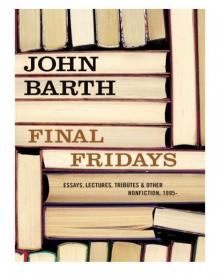 Final Fridays
Final Fridays Where Three Roads Meet: Novellas
Where Three Roads Meet: Novellas Every Third Thought: A Novel in Five Seasons
Every Third Thought: A Novel in Five Seasons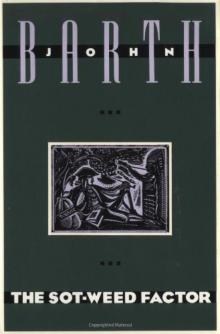 The Sot-Weed Factor
The Sot-Weed Factor The Friday Book
The Friday Book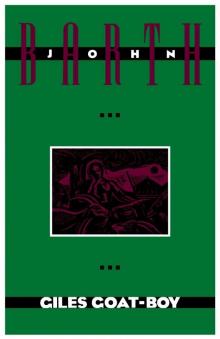 Giles Goat Boy
Giles Goat Boy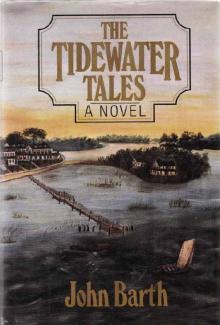 The Tidewater Tales
The Tidewater Tales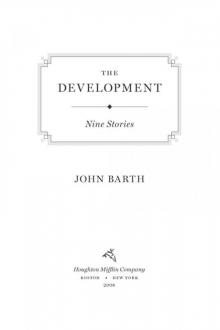 The Development
The Development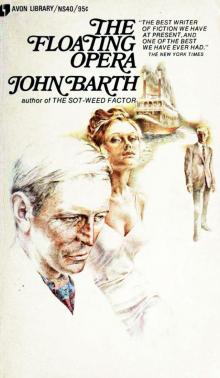 The Floating Opera
The Floating Opera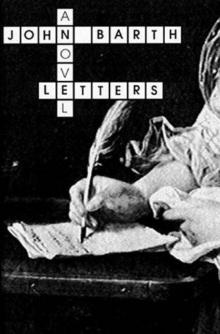 Letters
Letters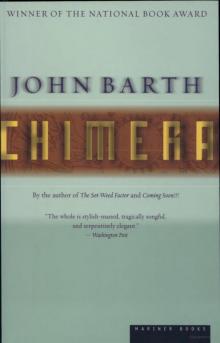 Chimera
Chimera Where Three Roads Meet
Where Three Roads Meet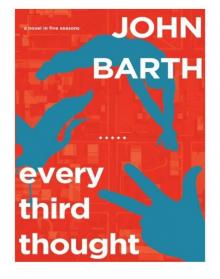 Every Third Thought
Every Third Thought